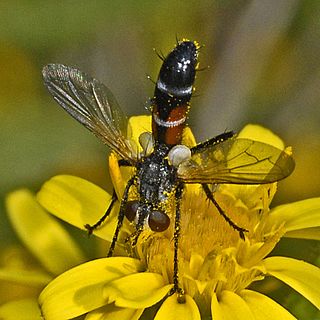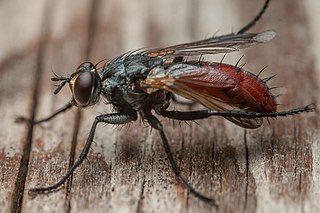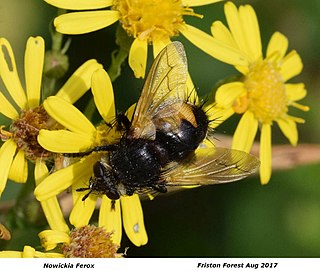
Eriothrix rufomaculatus is a fly in the family Tachinidae.

The Indian fritillary is a species of butterfly of the nymphalid or brush-footed family. It is usually found from south and southeast Asia to Australia.

Phytomyptera is a genus of bristle flies in the family Tachinidae. There are at least 60 described species in Phytomyptera.

Rutilia is a large genus of medium to large (>20mm) flies in the family Tachinidae native to Australia and the Oriental region, though notably absent from New Zealand. Like the vast majority of tachinid flies, Rutilia species are parasitoids of other insects, specifically Rutilia are known to be parasitoids of late instar larvae of scarab beetles.

Trigonospila is a small genus of parasitic flies in the family Tachinidae.
Zenargomyia is a genus of tachinid flies in the family Tachinidae from New South Wales. It is a parasite on the Cypress Pine Sawfly Zenarge turneri.

Tachina fera is a species of fly in the genus Tachina of the family Tachinidae. It was first described by Carl Linnaeus in 1761.

Dexia rustica is a species of fly in the family Tachinidae.

Prosena siberita is a species of fly in the family Tachinidae.

Trigonospila brevifacies is a species of true fly in the family Tachinidae native to eastern Australia. This species is also found in New Zealand. Like the vast majority of tachinid flies, T. brevifacies is a parasitoid of other insects, specifically late larval stages of a number of species of Lepidoptera. It is also known as the Australian Leaf-Roller Fly or Leafroller Fly.

Ectophasia crassipennis is a species of 'parasitic flies' of the family Tachinidae, subfamily Phasiinae.
Trigonospila fasciata is a species of fly in the family Tachinidae.
Zosteromeigenia mima is a species of fly in the family Tachinidae and the sole representative of the genus Zosteromeigenia. Like the vast majority of tachinid flies, Z. mima is expected to be a parasitoid of other arthropods, likely the larvae of Lepidoptera, however few or no host records exist.

Cylindromyia interrupta is a species of fly in the family Tachinidae.

Cylindromyia bicolor is a European species of fly in the family Tachinidae.

Nemoraea pellucida is a species of fly in the family Tachinidae.
Sturmiopsis inferens is a species of fly in the family Tachinidae. It is native to Asia and is a parasitoid of various moth species whose larvae feed inside the stems of sugarcane, rice and other large grasses, including the Gurdaspur borer and the sugarcane shoot borer.

Nowickia ferox is a species of fly in the family Tachinidae first described by Georg Wolfgang Franz Panzer in 1809.

Phania speculifrons is a species of fly in the family Tachinidae.

Dinera carinifrons is a species of fly in the family Tachinidae. It is found in Europe and Asia.
















